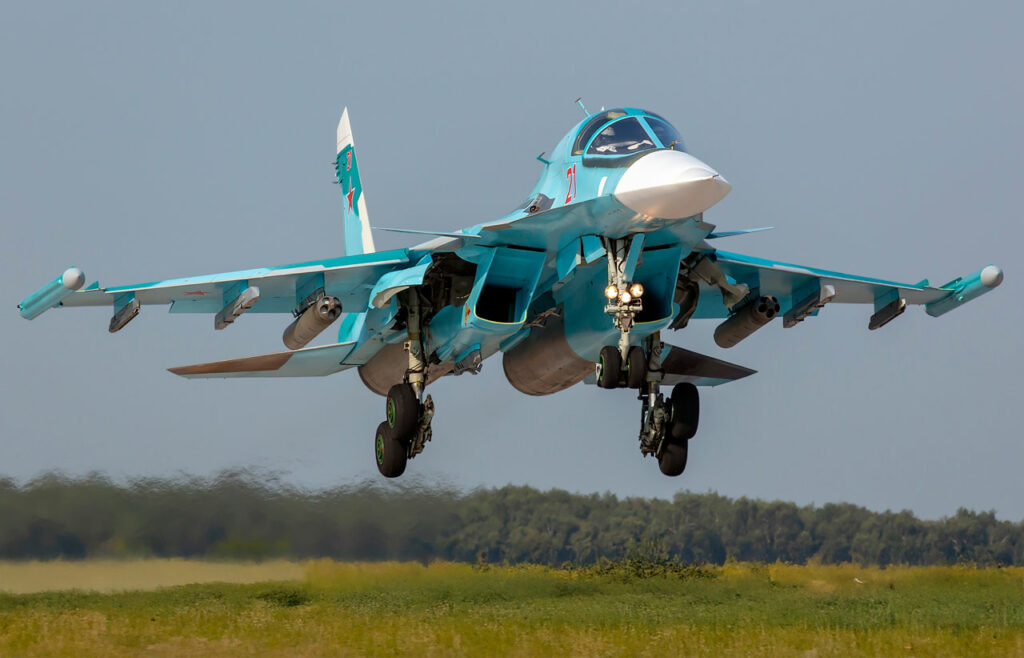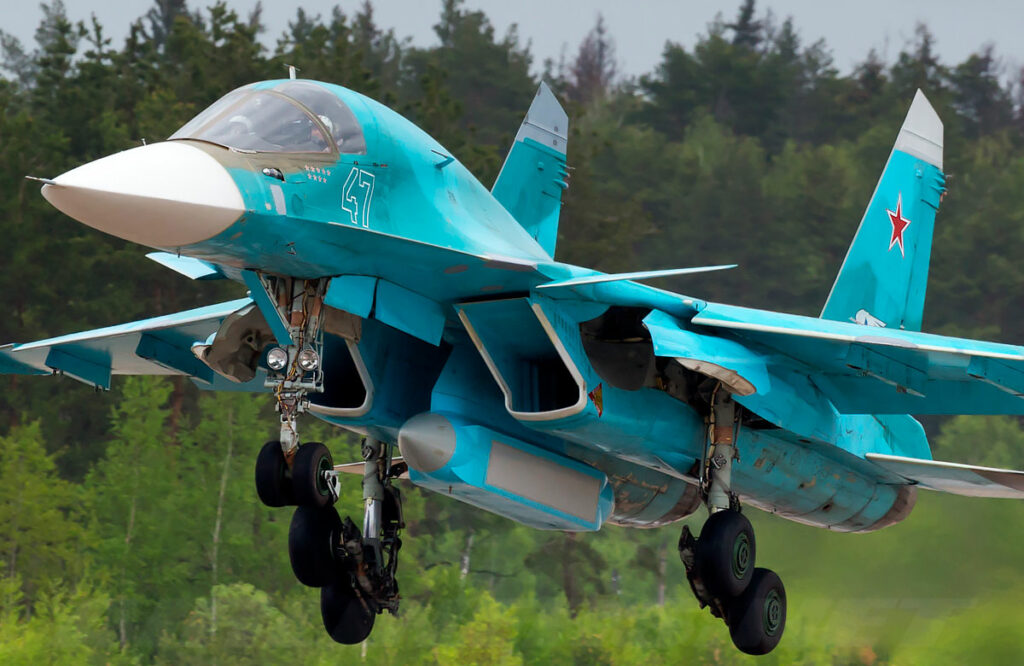The Sukhoi Su-34 Fullback is a Russian twin-engine, all-weather supersonic medium-range fighter-bomber with side-by-side seating.
The Sukhoi Su-34, designated “Fullback” by NATO, is a Russian twin-engine, twin-seat, all-weather supersonic medium-range fighter-bomber. Developed to replace the Su-24 “Fencer,” it features a side-by-side cockpit configuration, advanced avionics, and a robust airframe. Powered by two Saturn AL-31FM1 turbofan engines, the Su-34 achieves speeds up to Mach 1.8 and has a range of approximately 2,500 miles (4,000 kilometers) without refueling. It is equipped with a 30mm GSh-30-1 cannon and can carry up to 12,000 kilograms (26,455 pounds) of ordnance on 12 hardpoints, including air-to-air, air-to-surface, and anti-ship missiles. The aircraft’s design emphasizes crew comfort for long missions, incorporating an armored cockpit and facilities such as a galley and lavatory.

History of the Development of the Sukhoi Su-34 (Fullback)
In the 1980s, the Soviet Union recognized the need to modernize its tactical bomber fleet, particularly to replace the aging Su-24 “Fencer.” The Su-24, introduced in the early 1970s, had served as a frontline bomber but faced limitations in range, payload, and avionics by the mid-1980s. The objective was to develop an aircraft capable of performing deep strike missions with improved survivability, payload capacity, and advanced avionics.
The Sukhoi Design Bureau initiated the program in 1986, leveraging the Su-27 “Flanker” airframe as a foundation. The Su-27 was renowned for its agility and performance, making it a suitable candidate for adaptation into a strike role. The development aimed to create a platform that combined the Su-27’s aerodynamic strengths with enhancements tailored for ground attack missions.
The first prototype, designated T-10V-1, took to the skies on April 13, 1990. This initial flight marked a significant milestone, demonstrating the feasibility of the design modifications. The aircraft featured a widened forward fuselage to accommodate a side-by-side seating arrangement for the two crew members, enhancing communication and coordination during missions.
The NATO reporting name “Fullback” was assigned to the Su-34, following the convention of assigning code names to Soviet and Russian aircraft. The name “Fullback” aligns with the pattern of using terms related to American football for Soviet bombers, though the specific reasoning behind each name is not publicly detailed.
The dissolution of the Soviet Union in 1991 led to economic challenges that impacted defense projects, including the Su-34 program. Despite these hurdles, development continued, albeit at a slower pace. The second prototype, T-10V-2, flew on December 18, 1993, incorporating refinements based on testing feedback.
Throughout the 1990s, the program faced budget constraints, leading to delays in production and deployment. However, the Russian Air Force maintained its commitment to the Su-34, recognizing its potential to enhance strike capabilities. In 2006, the first production models were delivered, marking the beginning of the aircraft’s integration into operational units.
The Su-34 officially entered service with the Russian Air Force in 2014, gradually replacing the Su-24 in frontline units. Its development spanned nearly three decades, reflecting the complexities of transitioning from Cold War-era designs to modern multi-role platforms. The aircraft’s introduction aimed to provide Russia with a versatile strike fighter capable of addressing contemporary and future combat requirements.
Design of the Sukhoi Su-34 (Fullback)
The Su-34’s design is a derivative of the Su-27 “Flanker,” incorporating significant modifications to fulfill its role as a fighter-bomber. The most noticeable change is the widened forward fuselage, accommodating a side-by-side seating arrangement for the two crew members. This configuration enhances crew coordination and allows for a more spacious cockpit environment, essential for long-duration missions.
The aircraft measures approximately 76 feet 5 inches (23.34 meters) in length, with a wingspan of 48 feet 3 inches (14.7 meters), and a height of 19 feet 8 inches (6.36 meters). The wing area is about 667 square feet (62.04 square meters), providing ample lift and stability. The airframe incorporates canard foreplanes, positioned ahead of the main wings, which improve maneuverability and control, especially during low-speed flight.
The Su-34 is powered by two Saturn AL-31FM1 turbofan engines, each producing approximately 30,865 pounds-force (137.2 kilonewtons) of thrust. These engines enable the aircraft to reach speeds up to Mach 1.8, approximately 1,190 miles per hour (1,900 kilometers per hour). The aircraft’s maximum takeoff weight is around 99,000 pounds (45,000 kilograms), allowing it to carry substantial fuel and weapon loads.
The cockpit is designed with crew comfort and safety in mind. The side-by-side seating arrangement allows for direct communication between the pilot and navigator/weapons officer. The seats are NPP Zvezda K-36DM ejection seats, providing zero-zero capability, meaning they can be used at zero altitude and zero airspeed. The cockpit is pressurized, allowing operations up to 32,800 feet (10,000 meters), and armored against small arms fire and shrapnel. The crew has access to amenities such as a small galley and a lavatory, ensuring comfort during extended missions.
The Su-34 has 12 hardpoints for carrying a variety of ordnance, with a maximum payload capacity of 12,000 kilograms (26,455 pounds). It is equipped with a 30mm GSh-30-1 cannon for close-range engagements and can carry a mix of air-to-air, air-to-surface, and anti-ship missiles, as well as guided and unguided bombs. The radar system, the Leninets B004, offers advanced terrain-following and targeting capabilities, critical for its strike role.
The aircraft’s landing gear is reinforced for rough field operations, providing versatility in deployment. The overall design of the Su-34 emphasizes survivability, versatility, and mission flexibility, making it a valuable asset in both conventional and asymmetric warfare scenarios.
Performance of the Sukhoi Su-34 (Fullback)
The Su-34’s performance characteristics reflect its dual role as a fighter-bomber. Powered by two Saturn AL-31FM1 turbofan engines, it generates a combined thrust of approximately 61,730 pounds-force (274.4 kilonewtons). This power enables the aircraft to reach a maximum speed of Mach 1.8 (approximately 1,190 mph or 1,900 km/h) at altitude. The engines are reliable and optimized for sustained supersonic flight and high maneuverability.
The operational range of the Su-34 is around 2,500 miles (4,000 kilometers) without aerial refueling, which extends to 4,000 miles (6,500 kilometers) with mid-air refueling capabilities. This range allows the Su-34 to perform deep-strike missions far beyond the frontlines. The service ceiling is 49,200 feet (15,000 meters), enabling it to operate at high altitudes and avoid certain threats during missions.
The aircraft’s payload capacity is one of its key strengths. With 12 hardpoints, it can carry a wide array of munitions, including guided and unguided bombs, anti-ship missiles like the Kh-35, air-to-surface missiles such as the Kh-29, and air-to-air missiles for self-defense. This versatility makes the Su-34 adaptable to a variety of mission profiles, from precision strikes to maritime operations.
In terms of avionics, the Leninets B004 radar system provides terrain-following and multi-target engagement capabilities. The system allows the Su-34 to navigate complex terrains at low altitudes, enhancing survivability during strike missions. It also features advanced jamming and electronic warfare systems, increasing its survivability in contested airspace.
Compared to its competitors, such as the F-15E Strike Eagle and the Panavia Tornado, the Su-34 excels in payload capacity and crew comfort for long-range missions. However, it is slightly slower and heavier, which can affect maneuverability in certain combat scenarios. Nonetheless, the Su-34’s combination of range, payload, and advanced avionics makes it a formidable platform in its category.

Variants of the Sukhoi Su-34 (Fullback)
The Su-34 has several variants tailored for different operational requirements:
- Su-34: The baseline version designed for strike missions, equipped with advanced avionics and a robust weapons suite.
- Su-34M: A modernized version featuring upgraded avionics, improved weapon systems, and enhanced electronic warfare capabilities. This variant began deliveries in 2022.
- Su-34 reconnaissance variant: Equipped with specialized pods for electronic intelligence (ELINT) and signals intelligence (SIGINT) missions, expanding its role beyond strike operations.
Military Use and Combat of the Sukhoi Su-34 (Fullback)
The Su-34 has been employed in various military conflicts, showcasing its capabilities as a strike platform. Its combat debut occurred during Russia’s intervention in Syria in 2015. The Su-34 conducted precision strikes against terrorist targets, including command centers, supply depots, and infrastructure. Equipped with guided munitions such as the KAB-500S-E bombs, the aircraft demonstrated high accuracy in neutralizing enemy positions.
The Su-34’s versatility was evident in its ability to perform maritime strike missions. It was deployed with Kh-35 anti-ship missiles during exercises and real-world scenarios, targeting hostile naval assets. Its advanced electronic warfare systems allowed it to operate in contested airspaces, jamming enemy radars and reducing the threat from surface-to-air missiles.
In addition to Syria, the Su-34 has been deployed in other conflict zones, including Ukraine. Reports indicate its use for deep strikes and close air support missions, leveraging its ability to carry heavy payloads and operate in adverse weather conditions.
The Su-34 has not been exported widely, as it remains a critical asset for the Russian Air Force. However, there have been discussions about potential sales to allied nations. Its advanced capabilities and relatively lower cost compared to Western counterparts make it an attractive option for countries seeking a modern strike platform.
Despite the Su-34’s successes, it has faced competition from aircraft like the F-15E Strike Eagle and the Eurofighter Typhoon. While these aircraft offer advanced capabilities, the Su-34’s unique blend of range, payload, and survivability ensures its relevance in modern warfare. It remains in active service with the Russian Air Force, with ongoing upgrades to enhance its operational effectiveness.
Back to the Fighter Jet section.